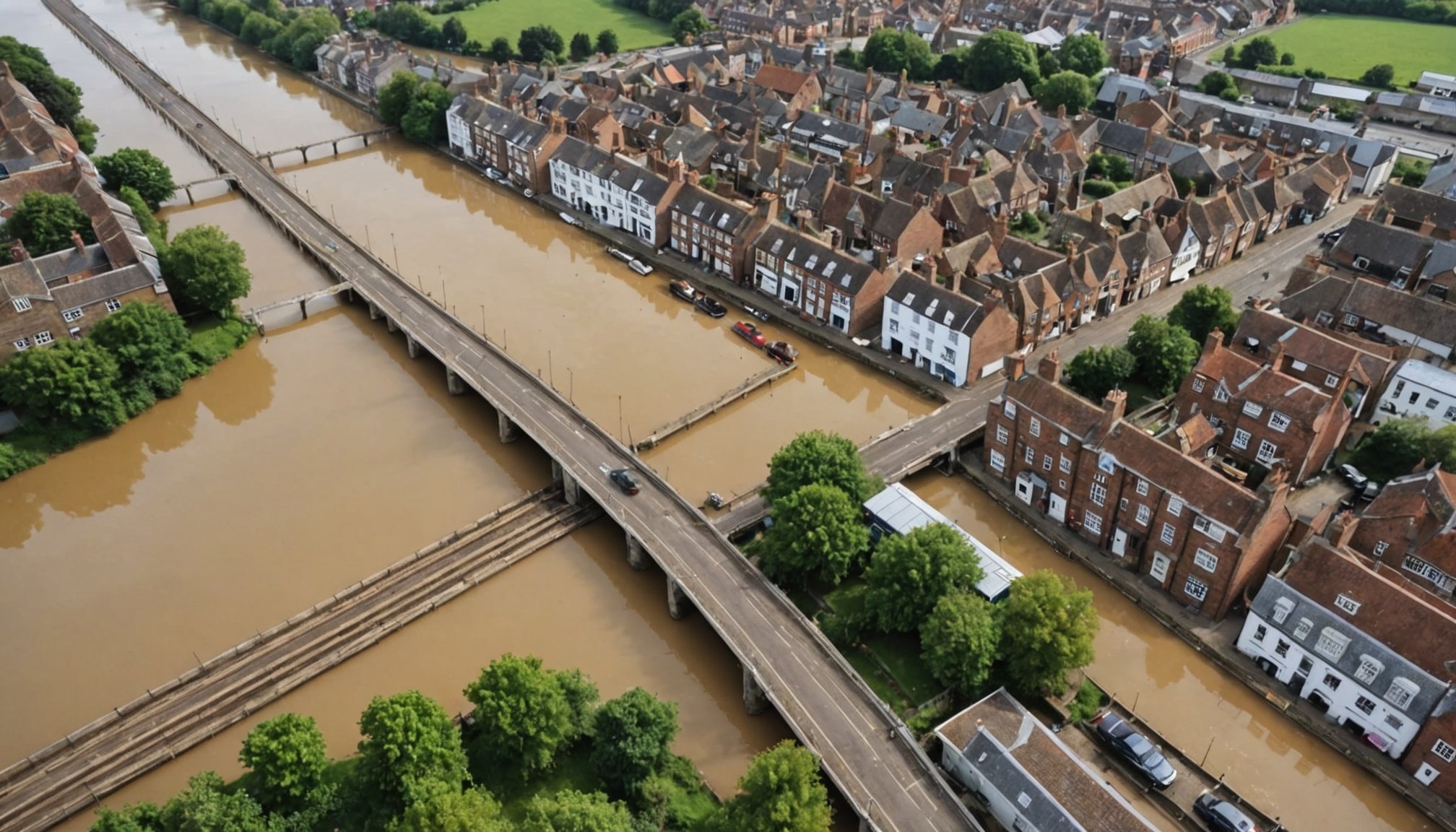Introduction to Flood Risk Management Innovations
As climate change continues to pose significant flood risk challenges, particularly in regions like the United Kingdom, the importance of innovative solutions has never been more critical. The UK’s landscape is increasingly vulnerable to severe flooding events, necessitating strategies that go beyond traditional methods. This article aims to explore various UK initiatives that represent cutting-edge advancements in addressing these risks.
To understand the gravity of current challenges, we must first consider the frequency and intensity of flood events affecting the UK. The economic and societal impacts are substantial, demanding urgent attention and innovative flood risk management strategies.
Also to discover : Revamping Your Home: Designing Versatile Spaces for Your Growing Family’s Needs
Innovative solutions in flood management often hinge upon technological advancements and sustainable practices, tailored specifically to the unique challenges presented by specific environments. In the following sections, we’ll delve into recent technological advancements, highlight sustainable management practices, examine government initiatives, and present case studies showcasing successful strategies adopted across different UK communities.
This comprehensive look at flood risk management not only aims to inform but also to encourage stakeholders at every level—community members, policymakers, and innovators—to collaborate in designing effective responses. By focusing on pioneering strategies and UK initiatives, we underscore the transformative potential of these efforts in safeguarding communities against floods.
Have you seen this : Transforming Heritage UK Homes: A Comprehensive Guide to Integrating Solar Energy Solutions Seamlessly
Recent Advancements in Technology for Flood Management
In the realm of flood management technology, smart systems and data analytics are redefining flood risk assessment. Advanced technologies now enable precise prediction and rapid response to flood events. For example, in Exeter, a smart flood sensor network, integrated with real-time data analytics, offers rich insights into flood patterns, enabling preemptive action. Such systems utilize vast datasets to anticipate flooding through weather patterns, stream gauge data, and soil moisture levels.
Case Studies in Technological Success
The Leeds Flood Alleviation Scheme provides a successful case study. Here, a combination of smart systems and adaptive technology has significantly reduced flood risks. This initiative employs moveable weirs controlled by real-time data inputs, allowing dynamic water flow management. Another innovative effort is in the Thames Valley, utilizing machine learning algorithms to efficiently predict and manage potential flood threats, showcasing a prime example of technological evolution in flood risk mitigation.
By implementing these cutting-edge technologies, the UK is setting benchmarks in flood management. As these innovations continue to evolve, they promise enhanced resilience and security for vulnerable communities, underlining the transformative power of technology in tackling flood challenges effectively.
Sustainable Practices in Flood Resilience
The concept of sustainable flood management is increasingly being recognized as vital for developing resilient communities. Green infrastructure plays a pivotal role by mimicking natural processes to manage water, reduce runoff, and improve flood resilience. These include parks, green roofs, and permeable pavements that absorb rainwater, thereby decreasing the severity of floods.
In the UK, various initiatives have exemplified the effectiveness of sustainable flood management. For instance, in Sheffield, the creation of urban green spaces has significantly minimized flood risks by enhancing water infiltration and retention. Similarly, the implementation of ecosystem services in York, such as wetland restoration, has proved beneficial. These strategies not only mitigate flood impacts but also restore habitats and promote biodiversity.
Incorporating ecosystem services into flood management plans offers multifaceted benefits. They provide cost-effective solutions compared to traditional engineering approaches, such as flood barriers. Additionally, they foster community engagement by involving local stakeholders in the planning and maintenance of green infrastructure. This holistic approach encourages long-term sustainability, crucial in a changing climate. Sustainable practices in flood resilience are, therefore, viable and necessary responses to growing challenges associated with climate-induced flooding.
Government Initiatives and Policy Frameworks
In the realm of UK flood policies, government initiatives play a crucial role in enhancing flood resilience across the nation. Various regulatory frameworks have been established to address the multifaceted challenges of flood risk management. such as the National Flood and Coastal Erosion Risk Management Strategy led by the Environment Agency, sets the direction for long-term resilience through effective planning and policy implementation.
Key initiatives like the Flood and Water Management Act empower local authorities, allowing for a more collaborative approach between government bodies and communities. This strategy facilitates the sharing of responsibilities and ensures that local needs are met. Moreover, these policies encourage the integration of innovative solutions alongside traditional methods, fostering a comprehensive approach to flood risk.
Collaboration extends beyond governmental entities to include partnerships with private sectors and communities. This integrated strategy fosters a sense of community-driven flood management, enabling regions to tailor solutions to their unique geographical and environmental challenges. Additionally, ongoing assessments and policy reviews are in place to adapt to emerging flood risks and climate change projections. These efforts underscore the UK’s commitment to safeguarding its communities while pioneering forward-thinking flood management practices.
Case Studies of Successful Flood Risk Management Strategies
Examining flood risk case studies reveals a wealth of best practices and insights into effective strategies. One notable example is the Hull City Council’s proactive flood management plan, which incorporated both traditional engineering and innovative solutions. After experiencing devastating floods, the city invested in improved drainage systems and real-time monitoring, significantly reducing flood risks.
In Gloucestershire, the Severn Embankment project showcases a best practice in community engagement and environmental conservation. The initiative not only strengthened flood defenses but also revitalized local ecosystems, highlighting the dual benefits of such holistic approaches. Lessons learned from this project stress the importance of involving local communities in flood management planning.
Meanwhile, the Medmerry Managed Realignment Scheme in West Sussex illustrates effective flood risk management through innovative solutions like managed retreat. By strategically breaching sea defences, new saltmarsh habitats were created, providing natural flood protection and boosting biodiversity. This approach sets a precedent for areas confronting similar challenges.
These case studies underscore the importance of adaptive, multi-faceted strategies in flood management. By looking at these success stories, other regions can replicate best practices, fostering resilience and preparedness against future flood events. They reinforce that blending engineering with ecological solutions can yield sustainable and effective results.
Expert Opinions and Future Directions
In the evolving domain of flood risk management, insights from flood risk experts are invaluable in shaping future solutions. Leading professionals highlight the need for increasingly innovative practices that harness the full potential of technology and community engagement. Experts stress that adopting an integrative approach—combining advanced technology, sustainable practices, and traditional methods—can provide comprehensive flood risk solutions.
Emerging Trends in Flood Resilience
Recent studies emphasize a shift towards more predictive and preventative strategies. Flood risk experts advocate for leveraging AI and machine learning to improve flood prediction models, enabling authorities to initiate timely evacuations and preparedness efforts. There’s also a growing focus on digital twins, which create virtual replicas of flood-prone areas to assess and simulate varying flood scenarios.
Recommendations for Policy and Practice
Policy-makers are encouraged to incorporate these future solutions into policy frameworks, ensuring adaptive and robust responses to burgeoning flood challenges. Experts recommend fostering collaborative networks that involve academics, technologists, and local communities, thus promoting a cohesive response strategy. Additionally, investing in continuous research and innovative practices will remain essential in developing tailored strategies that adapt to climate change’s shifting dynamics. Continuous adaptation of strategies will be crucial in building resilient communities that are well-equipped to manage future flood risks.





